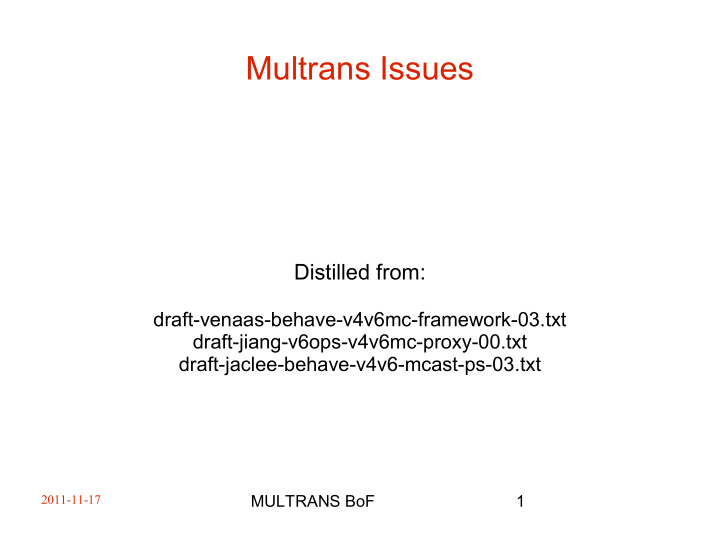



Multrans Issues Distilled from: draft-venaas-behave-v4v6mc-framework-03.txt draft-jiang-v6ops-v4v6mc-proxy-00.txt draft-jaclee-behave-v4v6-mcast-ps-03.txt MULTRANS BoF 1 2011-11-17
Contents Network example 1 (X-Y-Y) Issues 1-3 Network example 2 (X-Y-X) Issues 4-6 Network example 3 (6-4-6-4 Issue 7 MULTRANS BoF 2 2011-11-17
Network Example 1 IPvX-IPvY-IPvY AF1 Network 1 Src IPvY Rcvr IPvY IPvY AF = Adaption Function MULTRANS BoF 3 2011-11-17
Signalling Walk-Through 1. The Receiver/Set-Top Box sends a request for a specific channel to AF1. 2. AF1 maps the requested channel to IPvY unicast source and multicast group addresses. 3. AF1 sends a PIM join request toward the Source (SSM) or RP for the group (ASM). MULTRANS BoF 4 2011-11-17
Content Distribution Walk-Through 1. The Source sends packets of content to the corresponding multicast group in the IPvY Network. 2. The packets reach AF1. 3. AF1 maps the received IPvY source and destination addresses to the IPvX source and destination (multicast group) addresses it originally received in signalling. 4. AF1 forwards the content as IPvX packets to the receiver. MULTRANS BoF 5 2011-11-17
Issues (1) Mapping between IPv4 and IPv6 addresses is clearly a central requirement. Have RFC 6052 for unicast addresses. Need algorithm for multicast address mapping. MULTRANS BoF 6 2011-11-17
Issues (2) Assuming AF1 is an ALG: – What information must the Receiver/STB send to it to request a channel? – What information must be configured on the Receiver/STB? By what means? – What information must be configured on AF1? MULTRANS BoF 7 2011-11-17
Issues (3) The example shows AF1 as a dual stack element between the Receiver/STB and Network A. – What would be the differences between locating AF1 at the edge of the provider network vs. at the edge of the customer network. – Which one (provider edge vs. customer edge) is preferable under what circumstamces? MULTRANS BoF 8 2011-11-17
Network Example 2 IPvX-IPvY-IPvX Rcvr AF1 Network Network 1 AF2 2 Src IPvY IPvX Rcvr IPvX IPvY In Network 1: If ASM technology is used, AF2 is configured as the RP for the multicast group to which the Source belongs. If SSM technology is used, the network is configured to route toward the source through AF2. In Network 2, AF2 joins the multicast distribution tree for the Source. MULTRANS BoF 9 2011-11-17
Additional Signalling Steps 4.The PIM request sent by AF1 reaches AF2. 5.AF2 maps the IPvY unicast source and multicast groups addresses in the request to IPvX equivalents for the same channel. 6.If AF2 has not already done so, it sends a PIM join request into the IPvX network using the mapped source and group addresses. MULTRANS BoF 10 2011-11-17
Modified Content Distribution Steps 1. Source sends content packets to the IPvX multicast group. 2. The packets reach AF2. 3. AF2 maps the IPvX unicast source and multicast group addresses into the IPvY equivalents for the same channel, using the reverse mapping to the one used for signalling. 4. AF2 forwards the contents as IPvY packets with the IPvY source and the IPvY group as source and destination. etc. as before. MULTRANS BoF 11 2011-11-17
Issues (4) Should AF2 join the tree from the source permanently (join triggered by management action) or join and leave it dynamically based on signalling received across Network 1? – could be hybrid – join popular channels by management action, others on demand – signalling from AF1 to AF2 could be PIM or a higher level protocol (SIP, HTML, Netconf) MULTRANS BoF 12 2011-11-17
Issues (5) Could AF2 forward content packets as IPvX encapsulated in IPvY? Is this preferable to stripping the IPvX headers and adding IPvY headers? – Bear in mind that receivers downstream from AF2 may be a mixture of IPvX and IPvY. MULTRANS BoF 13 2011-11-17
Issues (6) What provision has to be made for multiple instances of the AF nodes for reliability, load balancing? MULTRANS BoF 14 2011-11-17
Network Example 3 (6-4-6-4) IPv6 Network Network Network 1 2 3 AF2 Src AF1 IPv4 IPv6 IPv4 Unicast Multicast Multicast IPv4 Rcvr IPv4 AF0 is owned by the customer. Roles of AF1 and AF2 are similar to those they had in the previous examples. Tunnel content from AF2 to AF1? MULTRANS BoF 15 2011-11-17
Issues (7) How does AF0 learn the address of AF1? -- IPv4-embedded IPv6 destination address sent by Receiver/STB? -- DNS based on receiver-provided URI? -- other? MULTRANS BoF 16 2011-11-17
Recommend
More recommend